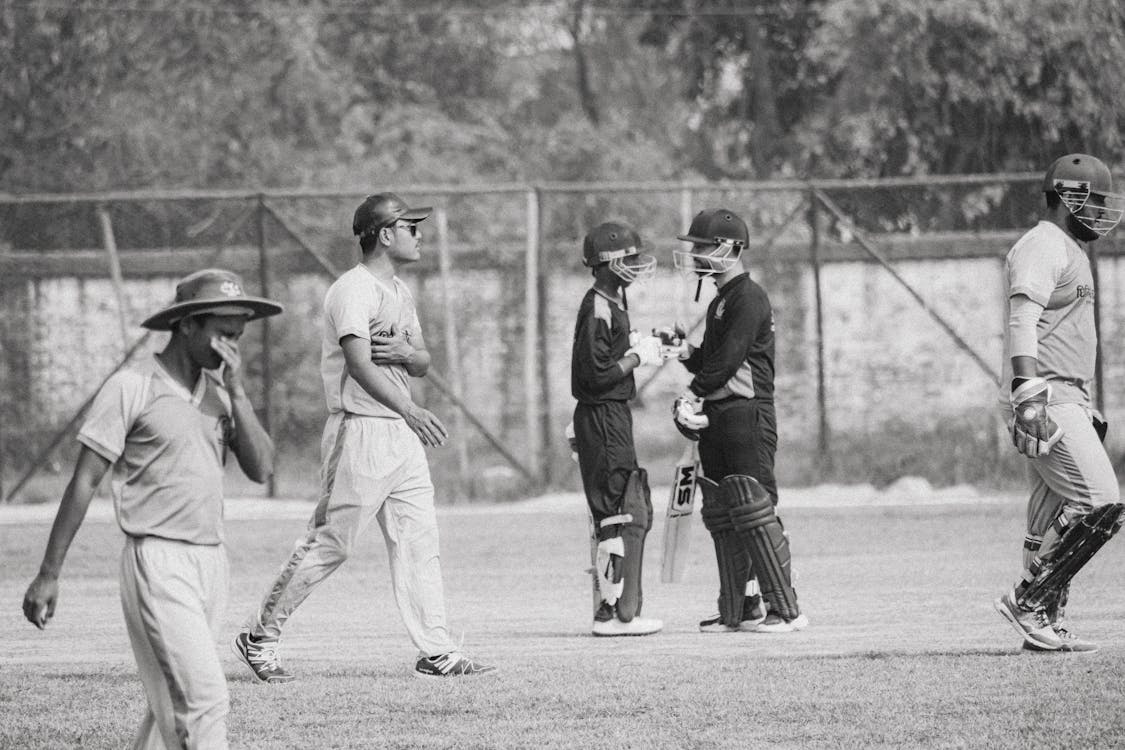Cricket is a sport that is loved in many countries around the world. The sport of cricket is not the simplest to understand but once you familiarise yourself with the basic rules, it can transform your entire experience. To enhance your knowledge, have a read through our cricket glossary to learn more about the sport.

Join the adventures of BC.GAME
Specific terms and conditions apply. 18+. Gamble Responsibly.
An Introduction Cricket Glossary
Once you have become acquainted with the basic rules of cricket, you can have an incredible experience of watching the game. Furthermore, the possibility of placing bets on the sport also becomes available. Continue reading through our cricket glossary from A to Z to expand your knowledge of cricket terminology.
Cricket Glossary
A
All-Rounder: A player who excels in both batting and bowling. All-rounders are highly valued for their ability to contribute in both aspects of the game.
B
Batsman: A player from the batting team who uses a bat to score runs by hitting the ball bowled by the opposition.
Bouncer: A short-pitched delivery bowled with the intention of rising to chest or head height, often used to intimidate the batsman.
Boundary: The outer edge of the cricket field, marked by a rope or a line. If the ball crosses the boundary without touching the ground, it results in either a four (if it bounces) or a six (if it goes directly over).
Bowler: A player from the bowling team who delivers the cricket ball towards the batsman with the aim of dismissing them.

C
Century: Scoring 100 runs individually in a single inning. A century is considered a significant achievement in cricket.
Crease: The marked lines on the pitch where the batsmen stand, and where the wicketkeeper stands while fielding. The creases help determine whether a batsman is in or out of their ground.
Cricket: A team sport played with a bat and ball, with two teams consisting of 11 players each. The primary objective is to score runs and dismiss the opposing team’s players.
D
Dead Ball: A state where play is temporarily halted by the umpire, often due to an event that hinders fair play, like the ball hitting a foreign object or the batsman.
Dibbly-Dobbly: A term used humorously to describe a bowler who delivers medium-paced, unthreatening deliveries that are easy for the batsman to handle.
DRS (Decision Review System): A technology-assisted system that allows teams to challenge on-field decisions, including LBW appeals and caught behind decisions, by using technology such as ball tracking and Hot Spot.
Duck: When a batsman gets out without scoring any runs in their inning, they are said to have made a “duck.”
Duckworth-Lewis Method: A mathematical system used to calculate target scores in rain-affected limited-overs matches, ensuring fair outcomes when weather interrupts play.
F
Fielding: The defensive aspect of the game, where the bowling team attempts to prevent the batting team from scoring runs by stopping the ball and fielding it efficiently.
Fielding Positions: Specific spots on the field where fielders are strategically placed to stop or catch the ball. Examples include slips, gully, mid-on, and deep square leg.
Follow-On: A situation in which the team that batted first has a substantial lead over the opposing team, and they enforce a follow-on, asking the other team to bat again without completing their first innings.
Follow-Through: The continuation of the bowler’s bowling action after releasing the ball. A good follow-through is crucial for accuracy and pace.
G
Gloves: Protective gear worn by the wicketkeeper and some batsmen to shield their hands from the impact of the ball.
Golden Duck: When a batsman gets out on the first ball they face, it is termed a “golden duck.”
Gully: A fielding position close to the slips, often used to catch edges from the batsman’s shots.
H
Hat-Trick: A rare achievement in which a bowler dismisses three consecutive batsmen with three consecutive deliveries in the same over.
Hawk-Eye: A ball-tracking technology used in DRS that visually represents the path of the ball and predicts where it would have gone after impact.
Hitting the Seam: Bowling technique where the bowler aims to make the ball land on a specific seam of the cricket ball to generate unpredictable movement off the pitch.
I
Innings: The period during which one team bats and the other team bowls. A standard cricket match consists of two innings per team in formats like Test matches, while limited-overs games have a single inning per team.
Inswinger: A type of delivery that swings into the batsman, making it difficult to judge the line and often resulting in edges or LBW dismissals.
L
LBW (Leg Before Wicket): A mode of dismissal in which the ball hits the batsman’s leg before the bat, and if the umpire deems it would have hit the stumps, the batsman is given out.
Leg Break: A type of spin delivery bowled by a leg-spin bowler that turns from leg to off when delivered by a right-arm bowler (and vice versa for a left-arm leg-spinner).
Leg Spin: A type of spin bowling where the bowler imparts spin to the ball with their wrist, causing it to turn from leg to off when delivered by a right-arm bowler (and vice versa for a left-arm bowler).
Long On/Long Off: Fielding positions near the boundary behind the bowler’s arm, often used to stop boundary shots.

Join the adventures of BC.GAME
Specific terms and conditions apply. 18+. Gamble Responsibly.
M
Maiden Over: An over in which no runs are scored by the batsmen, and no extras are conceded by the bowler.
Midwicket: A fielding position on the leg side, halfway between the batsman and the square leg.
N
Nets: Practice sessions where players hone their batting and bowling skills by facing or delivering balls in a confined, netted area.
Nightwatchman: A lower-order batsman sent to bat as the night falls, often to protect a specialist batsman from facing the new ball.
No Ball: An illegal delivery by a bowler that results in an extra run and a “free hit” for the batting team on the next ball. A no-ball can be called for various reasons, such as overstepping the crease.
O
One-Day International (ODI): A limited-overs format where each team is allowed a maximum of 50 overs in an inning. ODI matches are generally completed in a single day.
Outswinger: A delivery that moves away from the batsman after pitching, causing them to play away from their body and potentially resulting in edges.
Over: A set of six consecutive legal deliveries bowled by a bowler. Each team typically has a group of bowlers who take turns to bowl overs.
P
Paceman: A fast bowler who delivers the ball at high speeds, often exceeding 90 miles per hour. They use pace to unsettle the batsman.
Paddle Sweep: A delicate sweep shot played by the batsman to guide the ball fine towards the leg side, often used against spin bowlers.
Powerplay: A period during a limited-overs match where fielding restrictions are in place, allowing the batting team to take advantage and score more runs during the initial overs.

R
Red Cherry: A colloquial term for the red cricket ball used in Test matches. Bowlers often refer to getting the “red cherry” to indicate they are in the bowling action.
Run: The basic unit of scoring in cricket. Batsmen run between the wickets to accumulate runs. They can score multiple runs off a single delivery if they run quickly.
Runner: A substitute player allowed to run for an injured batsman who is unable to run between the wickets.
Run Chase: When a team tries to reach a target set by the opposition in limited-overs cricket, it is referred to as a “run chase.”
Run Out: A mode of dismissal in which a fielding team successfully dislodges the stumps while the batsmen are attempting a run, and at least one batsman is out of their crease.
S
Silk: A term used to refer to a batsman’s ability to score runs stylishly and effortlessly. A “silken touch” is indicative of a batsman’s grace and skill.
Sixer: Hitting the ball out of the playing field for six runs. This is often achieved by a powerful stroke by the batsman.
Sledgehammer: A term used to describe a batsman known for their powerful and aggressive style of play, capable of hitting sixes and fours with ease.
Sledging: The act of using verbal taunts and psychological tactics to disrupt the concentration of the opposing team’s players.
Spinner: A type of bowler who specializes in delivering spin on the ball to deceive the batsman. Spin bowlers use variations in the spin to outfox the batsman.
T
Test Match: The longest format of cricket, played over five days with no limit on the number of overs in an inning. Test cricket is considered the ultimate test of a cricketer’s skills and endurance.
Toss: The coin toss that determines which team will bat or bowl first at the start of a match. The winning captain makes the choice.
Twenty20 (T20): The shortest format of cricket, with each team allowed to bowl a maximum of 20 overs in an inning. T20 cricket is known for its fast-paced, entertaining style.
U
Umpire: Officials responsible for enforcing the rules, making decisions, and signaling the outcomes of deliveries and dismissals. There are usually two on-field umpires in a cricket match.
W
Wicket: A set of three wooden stumps and two bails placed at each end of the pitch. The batsmen try to protect the wicket, while bowlers attempt to dislodge the bails to get the batsman out.
Wicketkeeper: A player responsible for standing behind the stumps and fielding the ball delivered by the bowler. The wicketkeeper is also involved in run-out attempts.
Wide: A delivery that is too wide for the batsman to hit and is considered an extra run for the batting team. Wides are given when the ball is out of the batsman’s reach.
Wide Ball: A delivery that is too wide for the batsman to hit. In limited-overs cricket, wides result in an extra run being awarded to the batting team.
White Ball: The type of ball used in limited-overs cricket, which is usually white or light in color, in contrast to the red ball used in Test matches.

Y
Yorker: A type of delivery bowled by a fast bowler aiming at the batsman’s toes. A well-executed yorker is difficult for the batsman to hit and is often used in the late stages of an inning.

Join the adventures of BC.GAME
Specific terms and conditions apply. 18+. Gamble Responsibly.
Where to Play?
Now that you are more familiar with cricket terminology, the ability to stat placing wagers on the sport becomes available. One of the best options to do this is seen at the best online cricket betting sites. On that page, you will find a plethora of available sites, tailored to your country. One of the most popular picks among the bunch is BC.GAME Sportsbook.







